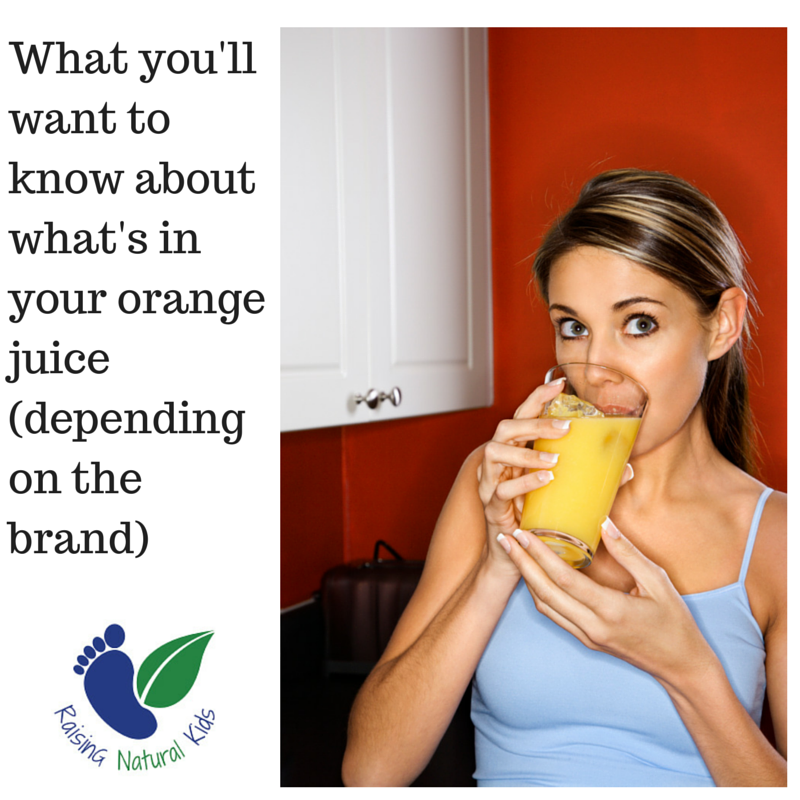Millions of Americans start their day off with a glass of orange juice with breakfast. Sounds simple enough; technically, orange juice has one ingredient – oranges, right? Right – if you make it yourself (which is really quite simple). BUT if you are buying it, that’s an orange of a different color (sorry, I just couldn’t help myself).
Take Simply Orange, for example.
The name implies that the orange juice inside is made solely from oranges. Sadly, the name of it is completely misleading, which is exactly what Coca-Cola, the company that owns it, wants. Just hearing that Coca-Cola owns it should stop and make you think. They are masters at making the public believe that their brands are perfectly safe, along with whatever else they want you to believe about it.
The truth is that Coca-Cola uses a formula with specific specifications and algorithms based on data about the exact taste and sweetness of an orange that consumers like best, and the juice is made to match. Part of this process involves sucking the oxygen out of the juice after the oranges are freshly picked and squeezed, so that it won’t spoil while it’s sitting in tanks waiting for the next step in its processing. The problem with this is that flavor is lost in the processing and the stripping of the oxygen. In order to make up for the flavor lost, flavor and fragrance companies are hired to formulate chemically processed ones (and there goes your natural orange flavor). These flavor and fragrance companies “engineer flavor packs to add back to the juice to make it taste fresh. Flavor packs aren’t listed as an ingredient on the label because technically they are derived from orange essence and oil. Yet those in the industry will tell you that the flavor packs, whether made for reconstituted or pasteurized orange juice, resemble nothing found in nature,” explains Alissa Hamilton, author of Squeezed: What You Don’t Know About Orange Juice.”
In a time when many people are wanting healthier, cleaner foods (minus the added chemicals), it’s getting harder and harder to discern what’s in the food and drinks on the store shelves these days. This is because the food manufacturers have caught on. People want natural, organic and whole foods, so they change their labels to reflect this want. Marketers for these companies play on people’s trust and manipulate their wording to make it seem that they are something that they are not. It’s always frustrating to find that something you think you’ve been doing right isn’t actually so good for you after all.
Here are some tips to help you navigate around the false advertisements and labeling of foods:
- Buy whole foods and make your meals and snacks from these whole foods. This way you know exactly what you’re eating (baring that you are using organic foods). For those who don’t know, “whole foods” refers to foods that are closest to their original form as found in nature.
- Purchase your whole foods from local farms and farmer’s markets. Right now is the time that these farms and markets are starting back up for the season. In addition to providing fresh fruits and vegetables, many farms and markets also provide access to organic, hormone free meats, poultry, dairy and eggs.
- When buying food in the grocery store, get organic there as well. Buying organic insures that your food is free of pesticides and that it is not genetically modified. In the produce section, this means that you want the number on the barcode to be five digits and to start with a 9. Of course, even with this, there are sometimes loopholes, but we do our best with what we can!
- Don’t just read the front of a box/container/can/bag of food. Read the ingredient list. If you can’t pronounce something, chances are that it’s not good for you. This includes misleading wording such as natural flavoring and spices. If that natural flavoring is listed in a product that has the USDA certified organic label, it is probably ok, but if it doesn’t, it’s almost always not good for you.
- Take a few minutes to learn about what corporations own which food companies. You’d be amazed at just who is controlling what. For instance, Coca-Cola owns 15 different drink companies, including Vitamin Water; Pepsico owns over 32 food, snack, cereal and drink companies, including Quaker Oats. These companies, along with ones owned by P&G, Kraft and Kellogg’s are ones that you can bet have ingredients that they are not being forthright about and/or aren’t ones you want in your food due to side effects related to cancer and other illnesses. Google “who owns organic” and you’ll find quite a surprise as well.
- Grow your own! There’s no better way to know what is going into your body than to have grown it seed to mouth. Start with organic, GMO free seeds. When plants are full-grown, save the seeds from some of your crop so that you don’t have to buy seeds next year.

Yes! I thought so! I just bought a two litre jug of the stuff because it was on sale and for some reason I just couldn’t get over the taste of it…. it just didn’t taste right to me
Hi! thank you for sharing and advice . ive learned a lot of things . i will share this to my friends. so they will be aware. good day!